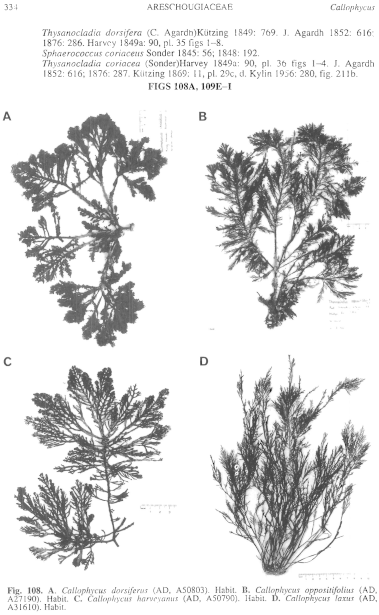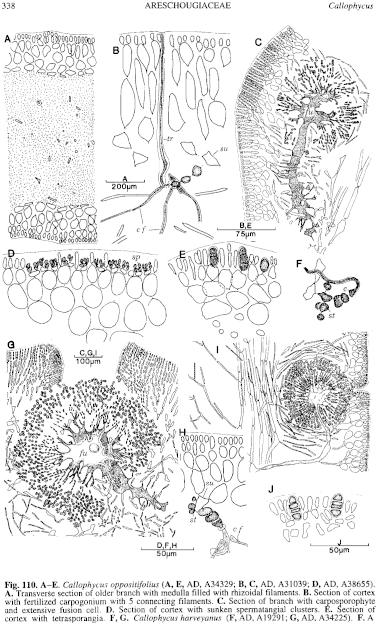|
|
|
|
|
|||||||||||
|
Electronic Flora of South Australia Species Fact Sheet
Phylum Rhodophyta – Class Florideophyceae – Order Gigartinales – Family Areschougiaceae
Selected citations: Min-Thein & Womersley 1976: 27, figs 9, 10, 52B.
Synonyms
Thysanocladia harveyana J. Agardh 1876: 287. Kylin 1932: 14. Lucas & Perrin 1947: 175.
T. laxa sensu Harvey 1855a: 550; 1862: pl. 211 [NON Sonder 1853: 689].
Thallus (Fig. 108C) dark red-brown, 10–40 cm high, complanately branched with one to several main branches (2–) 3–5 mm broad from a short stipe, branches compressed, without a midrib, bearing slightly narrower, subopposite, distichous pinnae which are mostly basally constricted and irregular in length, often developing into longer branches; pinnules compressed, usually simple, 0.5–2 cm long and 1–3 mm broad, margin entire. Holdfast discoid, 5–10 mm across, with a single stipe; epilithic. Structure multiaxial, with a core of medullary filaments and rhizoids and a pseudoparenchymatous cortex 5–8 cells thick, inner cells ovoid, 15–25 µm in diameter, and outer cells 3–5 µm in diameter. Rhodoplasts discoid, several per cell.
Reproduction: Sexual reproduction non-procarpic. Carpogonial branches (Fig. 110F) 3 (–4)-celled, borne on an inner cortical cell with the basal cell often bearing 1–2 sterile cells or short chains, projecting inwards with a reflexed trichogyne. Connecting filaments several, unbranched and non-septate. Auxiliary cell and adjacent inner cortical cells becoming darker staining after diploidization and producing branches of small cells; gonimoblast initials first produced inwardly, later radially from the fusion cell (which has an enlarged axial filament), with terminal chains of ovoid carposporangia (Fig. 110G) 6–10 µm in diameter. Cystocarps subterminal to midway long the pinnules, often crowded, hemispherical and protruding, with slight enveloping tissue, ostiolate. Spermatangia unknown.
Tetrasporangia unknown.
Type from Fremantle, W. Aust.; lectotype in Herb. Agardh, LD, 25565.
Selected specimens: Point Peron, W. Aust., drift (Parsons, 15.xi.1968; AD, A34328). Safety Bay, W. Aust., drift (Womersley, 18.viii.1979; AD, A50790 -"Marine Algae of southern Australia" No. 205). Eyre, W. Aust., drift (Gordon, 22.xi.1968; AD, A34225). 16 km E of Eucla, S. Aust., drift (Womersley, 3.ii.1954; AD, A19291).
Distribution: Port Denison, W. Aust., to 16 km E of Eucla, S. Aust.
Taxonomic notes: C. harveyanus is closely related to C. laxus, differing in its more regular and broader branches and pinnules.
References:
AGARDH, J.G. (1876). Species Genera et Ordines Algarum. Vol. 3, Part 1 - Epicrisis systematis Floridearum, pp. i-vii, 1–724. (Weigel: Leipzig.)
HARVEY, W.H. (1853). Nereis Boreali-Americana. Part II. - Rhodospermae. (Smithsonian Inst.: Washington.)
HARVEY, W.H. (1855a). Some account of the marine botany of the colony of Western Australia. Trans. R. Ir. Acad. 22, 525–566.
HARVEY, W.H. (1862). Phycologia Australica. Vol. 4, Plates 181–240. (Reeve: London.)
KYLIN, H. (1932). Die Florideenordnung Gigartinales. Lunds Univ. Årsskr. N.F. Avd. 2, 28 (8), 1–88, Plates 1–28.
LUCAS, A.H.S. & PERRIN, F. (1947). The Seaweeds of South Australia. Part 2. The Red Seaweeds. (Govt Printer: Adelaide.)
MIN-THEIN, U. & WOMERSLEY, H.B.S. (1976). Studies on southern Australian taxa of Solieriaceae, Rhabdoniaceae and Rhodophyllidaceae (Rhodophyta). Aust. J. Bot. 24, 1–166.
SILVA, P.C. (1957). Remarks on algal nomenclature. Taxon 6, 141–145.
The Marine Benthic Flora of Southern Australia Part IIIA complete list of references.
Publication:
Womersley, H.B.S. (14 January, 1994)
The Marine Benthic Flora of Southern Australia
Rhodophyta. Part IIIA, Bangiophyceae and Florideophyceae (to Gigartinales)
Reproduced with permission from The Marine Benthic Flora of Southern Australia Part IIIA 1994, by H.B.S. Womersley. Australian Biological Resources Study, Canberra. Copyright Commonwealth of Australia.
Illustrations in Womersley Part IIIA, 1994: FIGS 108C, 110F, G.

Figure 108 enlarge
Fig. 108. A. Callophycus dorsiferus (AD, A50803). Habit. B. Callophycus oppositifolius (AD, A27190). Habit. C. Callophycus harveyanus (AD, A50790). Habit. D. Callophycus laxus (AD, A31610). Habit.

Figure 110 enlarge
Fig. 110. A–E. Callophycus oppositifolius (A, E, AD, A34329; B, C, AD, A31039; D, AD, A38655). A. Transverse section of older branch with medulla filled with rhizoidal filaments. B. Section of cortex with fertilized carpogonium with 5 connecting filaments. C. Section of branch with carposporophyte and extensive fusion cell. D. Section of cortex with sunken spermatangial clusters. E. Section of cortex with tetrasporangia. F, G. Callophycus harveyanus (F, AD, A19291; G, AD, A34225). F. A carpogonial branch with basal sterile cells. G. Section of branch with carposporophyte. H–J. Callophycus laxus (H, I, AD, A38565; J, AD, A10928). H. Section of cortex with fertilized carpogonium with connecting filaments and supporting cell with 3 sterile cells. I. Longitudinal section with a carposporophyte, fusion cell, chains of carposporangia, and lax filamentous enveloping tissue. J. Transverse section of cortex with tetrasporangia. [A–I after Min-Thein & Womersley 1976.]

|
Email Contact: State Herbarium of South Australia |

|